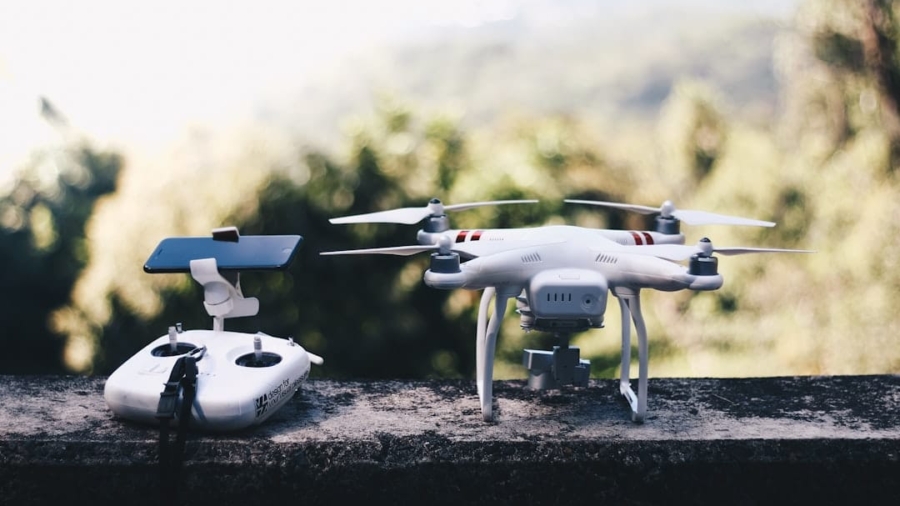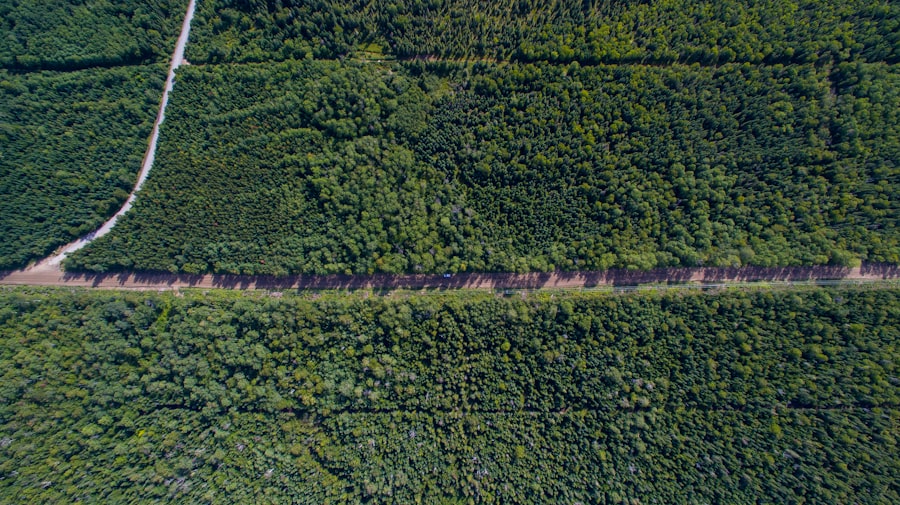The increasing urgency of addressing climate change and environmental degradation has led to innovative solutions in various fields, one of which is reforestation. Traditional methods of planting trees are often labor-intensive, time-consuming, and limited by geographical constraints. In this context, drones have emerged as a transformative technology, offering a new approach to reforestation efforts.
By leveraging aerial capabilities, drones can efficiently distribute seeds over large areas, monitor forest health, and gather critical data that informs conservation strategies. This article delves into the multifaceted role of drones in reforestation, exploring their benefits, challenges, and the future potential they hold for restoring ecosystems. As the world grapples with the consequences of deforestation—such as loss of biodiversity, soil erosion, and increased carbon emissions—the need for effective reforestation strategies has never been more pressing.
Drones represent a significant advancement in this arena, enabling rapid and precise planting of trees in areas that are often difficult to access. The integration of drone technology into reforestation efforts not only enhances efficiency but also opens up new possibilities for scaling up restoration projects. This article will examine how drones are being utilized in reforestation initiatives, the advantages they offer over traditional methods, and the challenges that must be addressed to maximize their impact.
Key Takeaways
- Drones are being increasingly used for reforestation efforts due to their ability to plant trees in hard-to-reach areas and monitor the progress of reforestation projects.
- Drones play a crucial role in reforestation by planting seeds, spraying pesticides, and monitoring the growth of trees, which helps in restoring degraded ecosystems.
- The benefits of using drones for reforestation include cost-effectiveness, efficiency, and the ability to cover large areas in a short amount of time.
- Challenges and limitations of using drones for reforestation include limited payload capacity, regulatory restrictions, and the need for skilled operators.
- Case studies of successful drone reforestation projects showcase the potential of drones in restoring forests and combating deforestation.
The Role of Drones in Reforestation
Drones play a pivotal role in modern reforestation efforts by facilitating the aerial distribution of seeds, which is often referred to as “drone seeding.” This method involves equipping drones with specialized seed pods that contain seeds along with nutrients and protective materials. The drones can then fly over designated areas, releasing these pods at calculated intervals and altitudes to ensure optimal germination conditions. This approach not only accelerates the planting process but also allows for the coverage of vast and challenging terrains that would be impractical for human planters.
In addition to seed dispersal, drones are instrumental in monitoring reforestation sites. Equipped with high-resolution cameras and sensors, drones can capture detailed images and data about the health of newly planted trees and the surrounding ecosystem. This information is invaluable for assessing growth rates, identifying areas that may require additional attention, and tracking changes in biodiversity over time.
By providing real-time insights into forest conditions, drones enable conservationists to make informed decisions and adapt their strategies as needed.
Benefits of Using Drones for Reforestation
The advantages of employing drones in reforestation efforts are manifold. One of the most significant benefits is the speed at which large areas can be covered. Traditional tree planting methods can be labor-intensive and slow, often requiring teams of workers to manually plant each seedling.
In contrast, drones can cover several hectares in a fraction of the time, dramatically increasing the scale of reforestation projects. For instance, a single drone can plant thousands of seeds in a single flight, making it possible to restore vast landscapes more efficiently than ever before. Moreover, drones can operate in challenging environments where human access is limited or dangerous.
Remote areas affected by natural disasters or rugged terrains can pose significant obstacles for traditional planting methods. Drones eliminate these barriers by providing a safe and effective means of reaching these locations. This capability is particularly crucial in regions that have suffered from deforestation due to logging, agriculture, or natural calamities like wildfires or floods.
By enabling reforestation in hard-to-reach areas, drones contribute to restoring ecosystems that might otherwise remain barren.
Challenges and Limitations of Using Drones for Reforestation
Despite their numerous advantages, the use of drones in reforestation is not without challenges. One significant limitation is the regulatory landscape surrounding drone operations. Many countries have strict regulations governing drone flights, particularly concerning altitude limits, no-fly zones, and licensing requirements for operators.
These regulations can hinder the deployment of drones in certain areas or complicate logistics for organizations seeking to implement drone-assisted reforestation projects. Another challenge lies in the technical aspects of drone seeding itself. While advancements have been made in developing seed pods that can withstand aerial dispersal, ensuring high germination rates remains a concern.
Factors such as seed selection, pod design, and environmental conditions all play critical roles in determining whether seeds will successfully take root after being dispersed from the air. Additionally, there is a need for ongoing research to optimize these parameters and improve the overall effectiveness of drone seeding techniques.
Case Studies of Successful Drone Reforestation Projects
Several successful case studies illustrate the potential of drones in reforestation efforts around the globe. One notable example is the “Billion Tree Campaign” initiated by the United Nations Environment Programme (UNEP), which aims to plant billions of trees worldwide to combat climate change and promote biodiversity. In collaboration with various organizations, drones have been employed in countries like Ethiopia and Madagascar to distribute seeds over large areas quickly and efficiently.
In Ethiopia, for instance, a project called “Green Ethiopia” utilized drones to plant trees in deforested regions. The initiative successfully deployed drones to cover vast landscapes that were previously inaccessible due to rugged terrain. By using drone technology, the project was able to plant over 350 million trees within a short timeframe, significantly contributing to national reforestation goals while also engaging local communities in conservation efforts.
Another compelling case study comes from the United States, where a company called “DroneSeed” has pioneered drone-assisted reforestation following wildfires. After devastating fires ravaged forests in California and Oregon, DroneSeed deployed its fleet of drones to plant tree seeds across affected areas. The company’s approach combines aerial seeding with ground-based monitoring to ensure that newly planted trees thrive in their environment.
This innovative strategy not only accelerates recovery efforts but also helps restore habitats for wildlife displaced by the fires.
Best Practices for Implementing Drone Reforestation Efforts
Thorough Planning and Site Assessment
Understanding the specific ecological characteristics of the area, such as soil type, climate conditions, and existing vegetation, is crucial for selecting appropriate seed species and determining optimal planting strategies. Engaging local communities and stakeholders during this planning phase can also enhance project success by fostering collaboration and ensuring that local knowledge is incorporated into decision-making processes.
High-Quality Seed Pods and Expert Collaboration
It is essential to invest in high-quality seed pods designed for aerial dispersal. These pods should be engineered to protect seeds from environmental stressors during flight while also providing necessary nutrients to promote germination once they reach the ground. Collaborating with agricultural scientists and ecologists can help refine pod designs and improve overall success rates.
Monitoring, Evaluation, and Adaptive Management
Monitoring and evaluation are critical components of successful drone reforestation efforts. Implementing a robust system for tracking growth rates and assessing ecological impacts will provide valuable insights into project outcomes and inform future initiatives. Utilizing drone technology for ongoing monitoring allows for real-time data collection and analysis, enabling adaptive management strategies that respond to changing conditions on the ground.
The Future of Drone Technology in Reforestation
The future of drone technology in reforestation holds immense promise as advancements continue to emerge at a rapid pace. Innovations in artificial intelligence (AI) and machine learning are poised to enhance the capabilities of drones further. For instance, AI algorithms can analyze data collected by drones to identify optimal planting locations based on factors such as soil health and moisture levels.
This level of precision could significantly improve germination rates and overall project success. Moreover, as battery technology advances, drones will be able to fly longer distances without needing frequent recharges. This increased endurance will expand their operational range, allowing them to cover even larger areas more efficiently.
Additionally, developments in autonomous flight technology may enable drones to operate independently without human intervention, further streamlining reforestation efforts. Collaboration between technology companies, environmental organizations, and governmental agencies will be crucial in shaping the future landscape of drone-assisted reforestation. By pooling resources and expertise, stakeholders can develop comprehensive strategies that leverage drone technology alongside traditional conservation methods.
Conclusion and Call to Action for Drone Reforestation Efforts
As we face an increasingly urgent need for effective solutions to combat climate change and restore degraded ecosystems, drone technology stands out as a beacon of hope in reforestation efforts worldwide. The ability to rapidly plant trees over vast areas while simultaneously monitoring ecological health represents a significant leap forward in conservation practices. However, realizing the full potential of drone-assisted reforestation requires collaboration among various stakeholders—governments, NGOs, researchers, and local communities must work together to overcome challenges and implement best practices.
To harness this innovative technology effectively, it is imperative that we invest in research and development while advocating for supportive regulatory frameworks that facilitate drone operations in conservation contexts. By embracing drone technology as a vital tool in our reforestation arsenal, we can take meaningful steps toward restoring our planet’s forests and mitigating the impacts of climate change for generations to come. The call to action is clear: let us unite our efforts to promote drone-assisted reforestation initiatives that not only restore ecosystems but also foster resilience against future environmental challenges.
Using drones for reforestation efforts has been a game-changer in the fight against deforestation. These unmanned aerial vehicles are equipped with technology that allows them to plant trees at a much faster rate than traditional methods. In a related article, Unlock the Power of the Galaxy with the Samsung S22 Ultra, the focus is on the cutting-edge technology of the Samsung S22 Ultra and how it can revolutionize the way we use smartphones. Just like drones are revolutionizing reforestation efforts, the Samsung S22 Ultra is pushing the boundaries of what is possible with mobile technology.
FAQs
What are drones?
Drones, also known as unmanned aerial vehicles (UAVs), are aircraft that are operated without a human pilot on board. They can be controlled remotely by a human operator or autonomously by onboard computers.
How are drones used for reforestation efforts?
Drones are used for reforestation efforts by planting tree seeds in areas that are difficult to access or are in need of reforestation. They can be equipped with special devices that can shoot seed pods into the ground, making the process more efficient and cost-effective.
What are the benefits of using drones for reforestation?
Using drones for reforestation efforts can help to reforest large areas quickly and efficiently. Drones can access remote or difficult terrain, and they can cover large areas in a short amount of time. This can help to speed up the reforestation process and improve the overall success of reforestation efforts.
Are there any challenges or limitations to using drones for reforestation?
Some challenges and limitations of using drones for reforestation efforts include the cost of the technology, the need for skilled operators, and potential regulatory restrictions. Additionally, the effectiveness of seed dispersal from drones may vary depending on environmental conditions and the type of seeds being planted.
What are some examples of successful reforestation efforts using drones?
There have been successful reforestation efforts using drones in various parts of the world, including areas affected by wildfires, deforestation, and natural disasters. For example, in Myanmar, drones have been used to plant mangrove trees in coastal areas to combat erosion and protect against storm surges.



